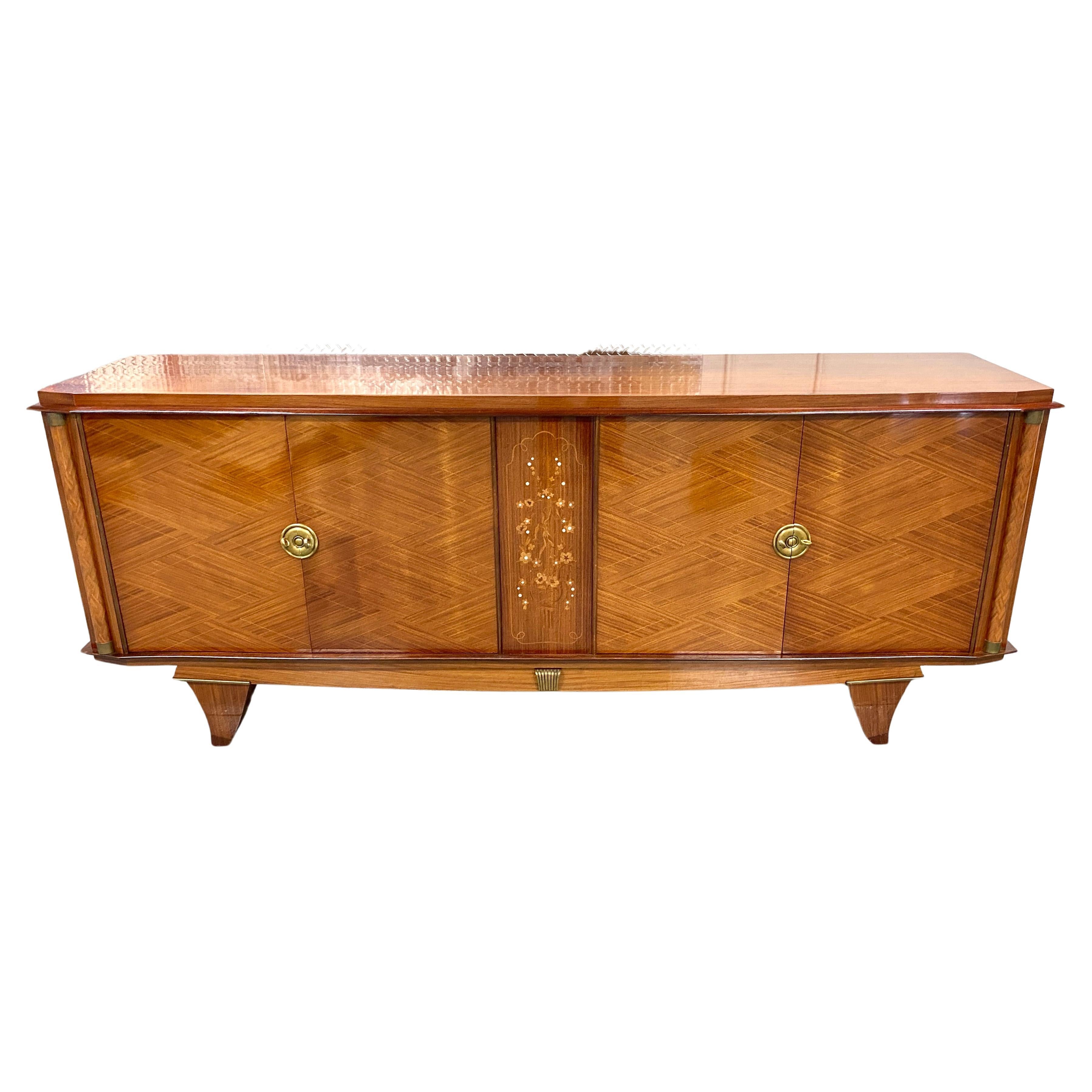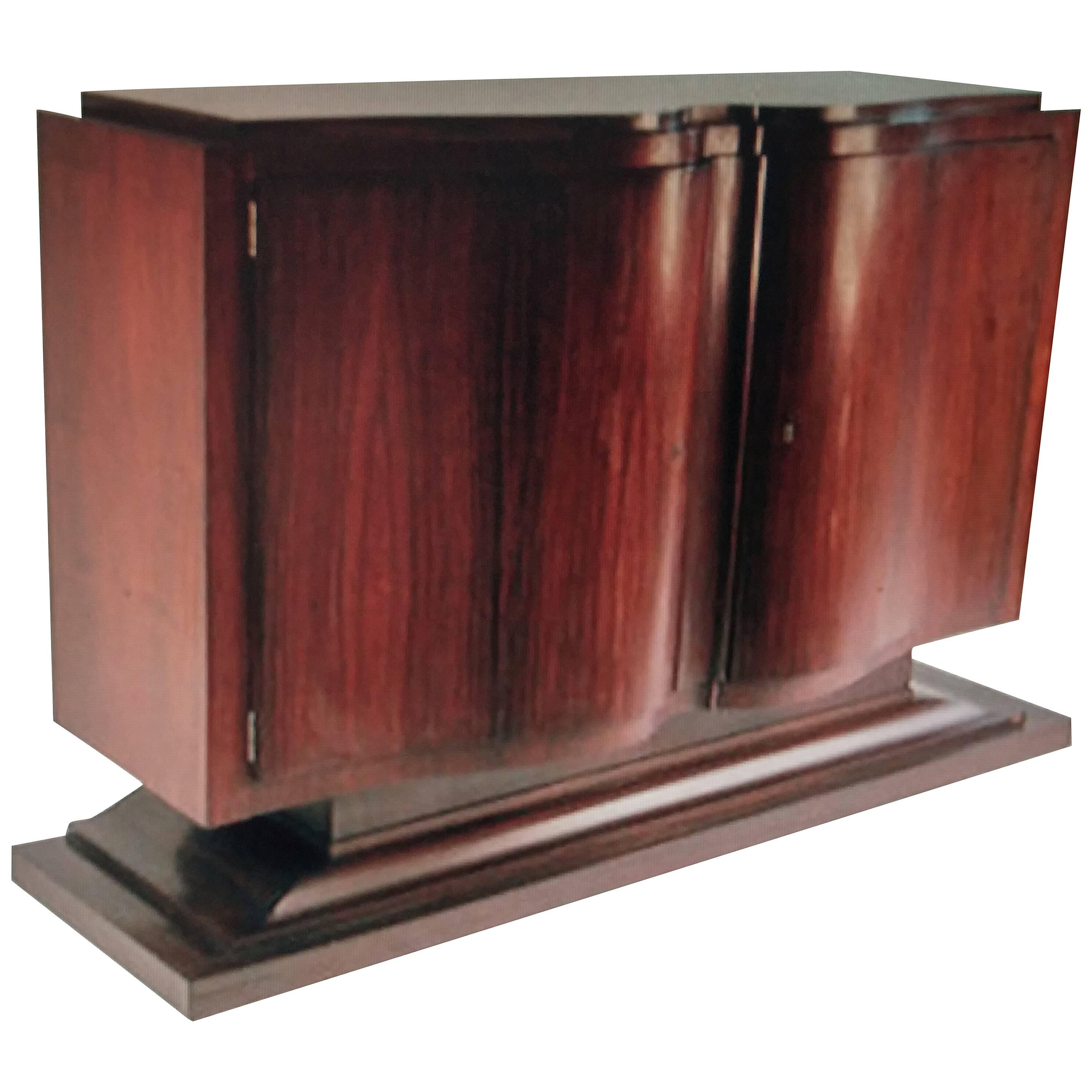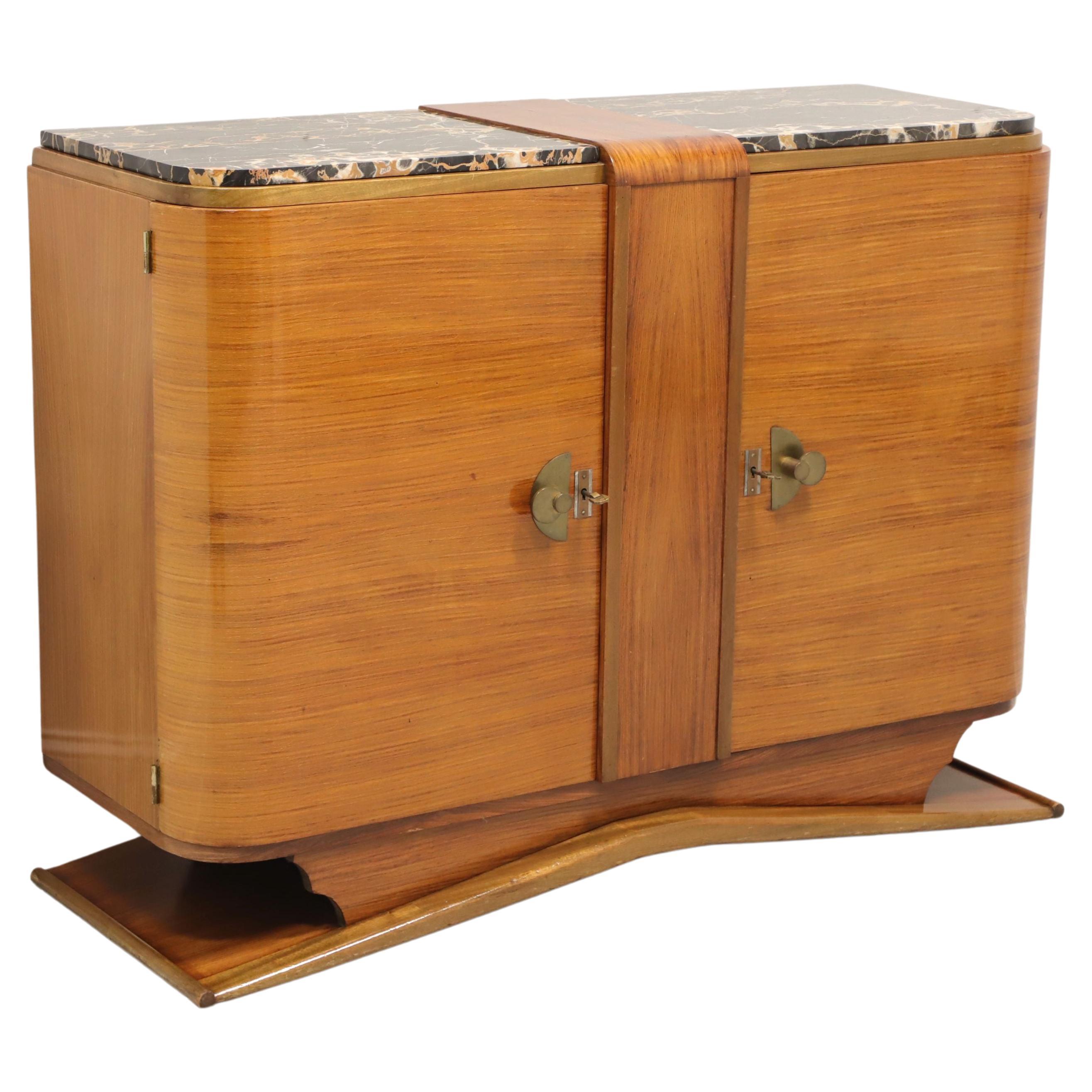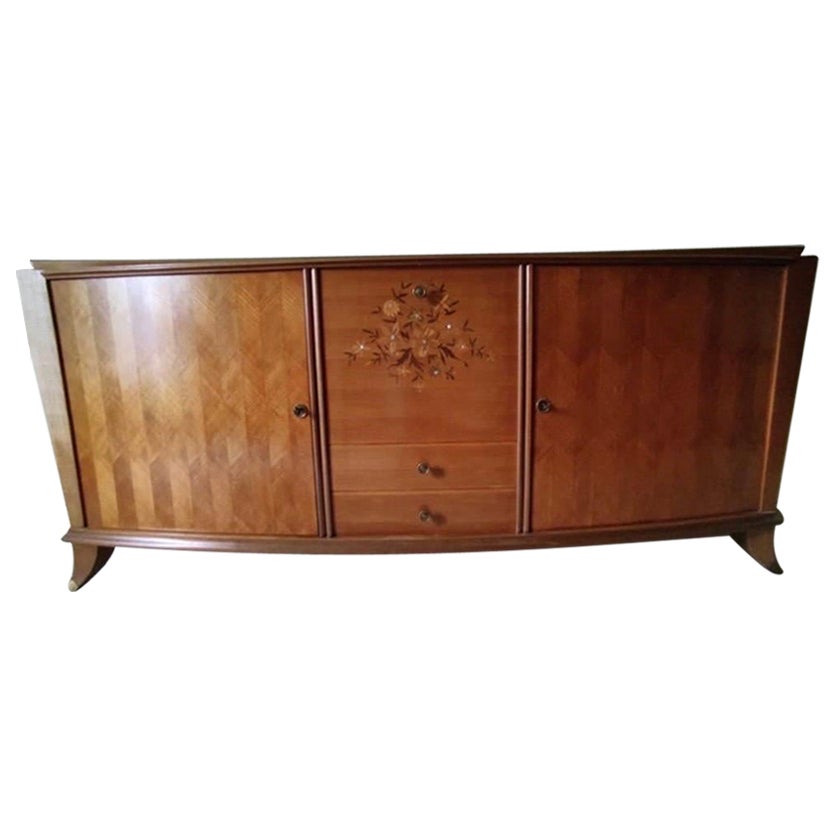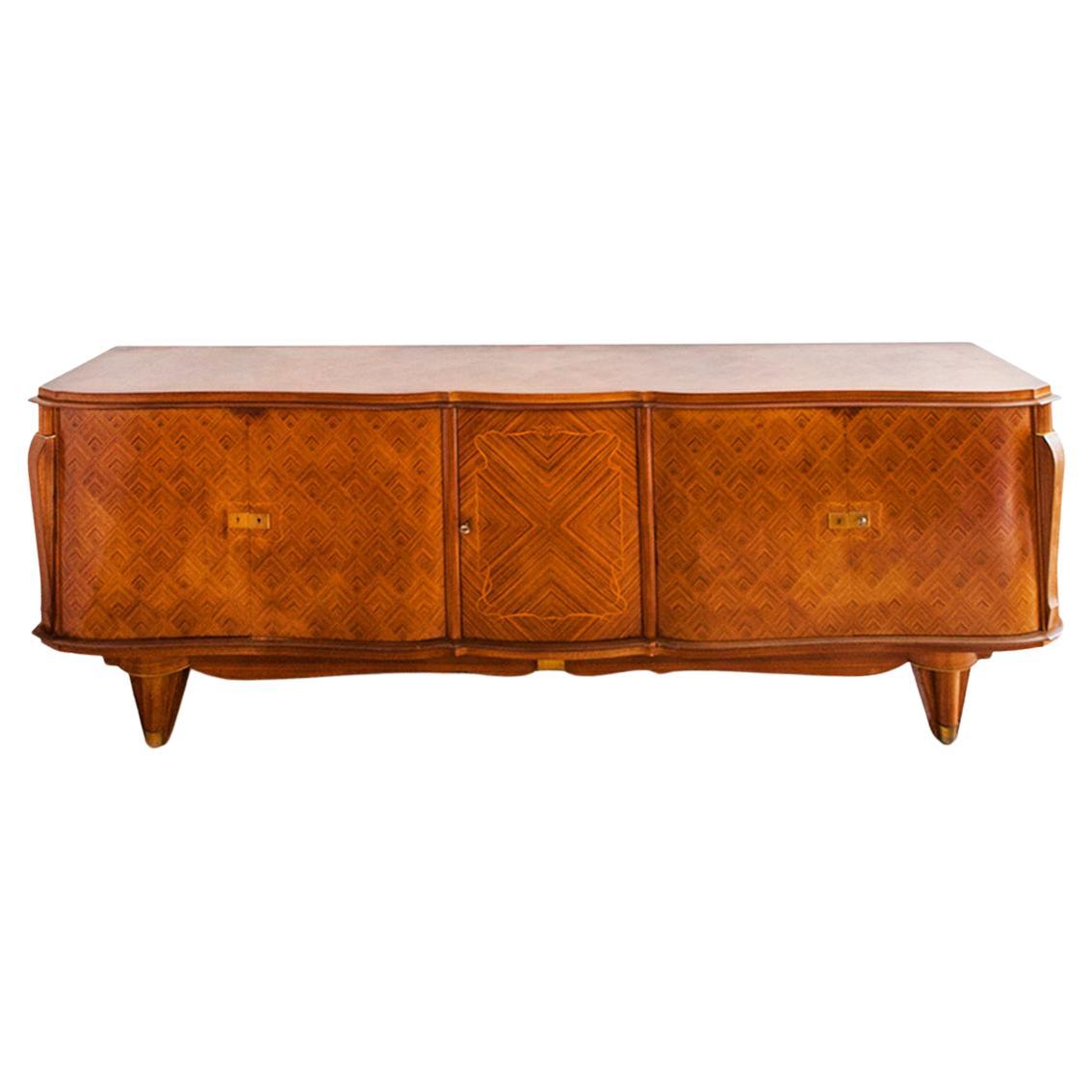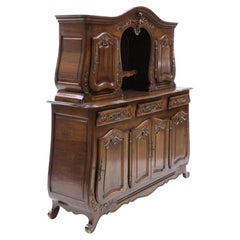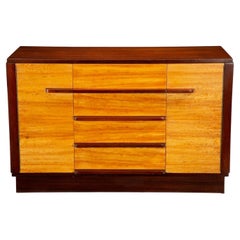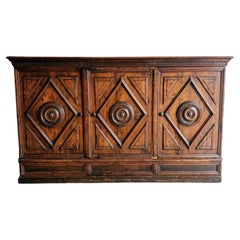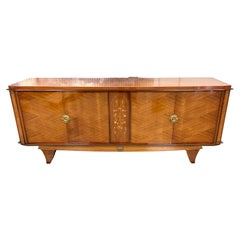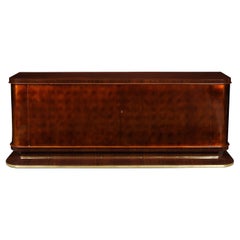
French Art Deco Moderne Painted Black Credenza Sideboard
View Similar Items
Want more images or videos?
Request additional images or videos from the seller
1 of 13
French Art Deco Moderne Painted Black Credenza Sideboard
About the Item
- Similar to:Jules Leleu (Designer)
- Dimensions:Height: 35 in (88.9 cm)Width: 86 in (218.44 cm)Depth: 23 in (58.42 cm)
- Style:Art Deco (Of the Period)
- Materials and Techniques:
- Place of Origin:
- Period:
- Date of Manufacture:circa 1930s/early 1940s
- Condition:Refinished. Wear consistent with age and use. Restored and finished in a later black paint finish.
- Seller Location:Forney, TX
- Reference Number:1stDibs: LU5977237494162
About the Seller
4.8
Platinum Seller
These expertly vetted sellers are 1stDibs' most experienced sellers and are rated highest by our customers.
Established in 2013
1stDibs seller since 2021
200 sales on 1stDibs
More From This SellerView All
- Exceptional French Louis Majorelle Art Nouveau SideboardBy Louis MajorelleLocated in Forney, TXAn extraordinary French walnut cabinet by Louis Majorelle (1859–1926) exceptionally executed period Art Nouveau styling. Circa 1900. Majorelle know for often ornamented his pieces...Category
Early 20th Century Art Nouveau Credenzas
MaterialsWalnut
- Art Deco Wolfgang Hoffmann Romweber World's Fair Century of Progress SideboardBy Romweber Furniture Co., Wolfgang HoffmannLocated in Forney, TXA rare and important American Art Deco Century of Progress Sideboard by iconic designer Wolfgang Hoffmann (Austrian, 1900-1969) for Romweber Company, Batesville, Indiana. circa 1933-1936 Created for the 1933 Chicago World's Fair, fine quality craftsmanship and construction, having a rectangular exotic rosewood veneered top over conforming solid wood case fitted with four drawers affixed with horizontal pulls, the top drawer opening to reveal felt lined divided interior for silverware, flanked by cabinet doors opening to shelved interior, subtle geometric lines add interest. Rosewood, mahogany, richly figured blonde - golden birch or primavera. Signed, top drawer interior, featuring 1933 World's Fair mark impressed. **Please note, at the time of writing this, a matching display case - vitrine cabinet (shown in last photo) is currently available separately** Provenance / Acquisition: Property from the important and iconic Collection of Mr. James I. Rafftesaeth Jr., Dallas, Texas Acquired from highly reputable auction house, Heritage Auctions, Dallas, Texas. 2022 Design Signature Auction catalog #8091 History: Wolfgang Hoffmann was born in Vienna, Austria in 1900. He is the son of famous architect, pedagogue and Wiener Werkstatte cofounder, Joseph Hoffmann (1870-1956). Early on, following his father’s s interests, he was trained in the decorative arts and design. Wolfgang Hoffmann once reminisced, “I spent eight years at the Realschule, then three years went to a special architectural school, where I perfected my technical knowledge of architecture and general construction. From this school, I was graduated to the Kunstgewerbeschule [Studying under Oskar Strnad and Josef Frank in Vienna]. After finishing this school, I had one and a half years of practical in a well known architect’s office. Thereafter I worked in my Father’s office for two years”. Hoffmann met his future wife, Polish immigrant Pola (1902-1984) when they were both studying at the Kunstgewerbeschule. Joseph Urban (1872-1933) was needing an assistant for his architectural business in New York and contacted his friend and colleague, Joseph Hoffmann in Vienna. Hoffmann recommended his son Wolfgang. Urban hired him and sent a first class passage ticket to Vienna for Wolfgang to travel to New York. Wolfgang married Pola and traded his ticket for two tickets to America in steerage, arriving in New York City in December of 1925. Leaving the Urban office after nine months, Wolfgang and Pola formed an independent design practice with offices on Madison Avenue in Manhattan with the purpose of creating contemporary interiors and industrial designs. Early work included theaters, stores, and apartments mostly in New York City. During the late 1920’s and early 1930’s the Hoffmanns designed custom furniture for private clients. Some of these examples were shown in the February 1929 issue of House and Garden. Curiously, the examples’ design was attributed to Urban and the production to Pola Hoffmann, Inc. Established in the fall of 1928, the American Designers’ Gallery was “devoted exclusively to showing objects and interiors for practical use… by fourteen American architects and designers”. Its members included the Hoffmans and Urban as well as ceramist Henry Varnum Poor (1888-1971), architect Raymond Hood (1881-1934), artist designer Winold Reiss (1886-1953), graphic designer Lucien Bernhard (1896-1981), decorator Donald Deskey (1894-1989), and architect Ely Jacques Kahn (1884-1972). The Hoffmanns’ work was included in the American Designers’ Gallery’s two showcase events, its 1928 and 1929 exhibitions. Their dining alcove at the 1929 event featured a bench with a dinette table and two chairs in American walnut designed by Wolfgang and a rug by Pola. Lucien Bernhard, fellow Austrian immigrant who settled in New York a year before the Hoffmanns, operated the gallery and decorating service Contempora with Munich resident Bruno Paul (1874-1968). The Hoffmanns, occasionally participating with Contempora, designed a number of outstanding interiors, including the constructivist living room of 1930 for Mrs. O.R. Sommerich at 40 East 66th street. In 1934, Donald Deskey commissioned Wolfgang to design birchwood furnishings for the eclectic apartment at 625 Park Avenue belonging to Helena Rubinstein. In 1931, Wolfgang exhibited his work at the Pennsylvania Art Museum and the Museum of Modern Art in New York City. The same year, with Kem Weber (1889-1963) he organized the second and final exhibition of AUDAC- “Modern Industrial and Decorative Arts”- at the Brooklyn Museum. At this event, the Hoffmanns showed the dining room previously included in the American Designer’s Gallery’s 1929 exhibition in the Chase Bank Building lobby at 145 West 57th Street in Manhattan. In 1932 Wolfgang was asked to assist Urban in developing the color scheme for the 1933-34 Chicago World’s Fair “A Century of Progress”. He was also commissioned to design the interior and furniture for the fair’s lumber industries house. There he executed its living and dining rooms furnished by Kroehler Manufacturing Company of Chicago; the boys’ room by Shower Brothers...Category
Early 20th Century American Art Deco Sideboards
MaterialsBirch, Mahogany, Rosewood
- Early 18th Century Italian Baroque Period Carved Walnut Sideboard CredenzaLocated in Forney, TXA rare and exceptional Baroque period hand carved walnut sideboard (buffet - credenza) with beautifully aged patina. circa 1700 Hand-crafted in Italy, likely Florence or Bologna, in the early 18th century, possibly 17th century, featuring handsome rich antique walnut...Category
Antique Early 18th Century Italian Baroque Sideboards
MaterialsWalnut
- Early 19th Century Country French Bordeaux SideboardLocated in Forney, TXSouthwestern France, circa 1820, Provincial Picardie influences, having a rectangular three board planked top, over a trio of frieze drawers, featuring central open shelf wine bottle...Category
Antique Early 19th Century French Country Sideboards
MaterialsFruitwood
- Vintage Country French Louis XV Style Fruitwood SideboardLocated in Forney, TXAn exceptional vintage country French Louis XV style fruitwood breakfront sideboard. Hand-crafted in France during the first half of the 20th c...Category
Early 20th Century Louis XV Sideboards
MaterialsFruitwood
- French Provincial Louis XV Grand Regence Style Breakfront SideboardLocated in Forney, TXA vintage French Provincial Louis XV style carved walnut sideboard. Hand-crafted in France in the mid-20th century, excellent quality, exceptionally executed in timeless 18th cent...Category
Antique 18th Century French Louis XV Sideboards
MaterialsMarble
You May Also Like
- Jules Leleu French Art Deco Credenza Sideboard or BuffetBy Jules LeleuLocated in Miami, FLA Masterful Statement Piece: Art Deco Credenza Attributed to Jules Leleu This exquisite Art Deco credenza, attributed to the renowned French designer Jules Leleu, embodies the eleg...Category
Early 20th Century French Art Deco Sideboards
MaterialsBrass
$20,750 Sale Price24% Off - French Art Deco Sideboard, Buffet, CredenzaLocated in Long Island City, NYThis extraordinary and rare 1935 French Art Deco streamlined sideboard would stand out and enhance a modern decor. It is part of a complete dining room set. Consisting of a matching ...Category
Mid-20th Century French Art Deco Sideboards
MaterialsSatin, Mahogany
- French Art Deco SideboardBy Jules LeleuLocated in New York, NYOf rounded form, having a Rosewood top and plinth edged with brass straps. The doors and body lacquered in deep caramel over gold leaf, the two doors opening to a fitted sycamore int...Category
20th Century Sideboards
MaterialsBrass
$55,000 - French Art Deco Sideboard Credenza Bakelite HandlesLocated in New York, NYRare early Art Deco, walnut sideboard/credenza. Lovely walnut grain, original bakelite handles and plenty of storage space.Category
Vintage 1930s French Art Deco Sideboards
MaterialsWalnut
- Jules Leleu Attributed Art Deco French SideboardBy Jules LeleuLocated in Bradenton, FLA French Art Deco period sideboard attributed to Jules Leleu. Made of mahogany, it consists of four seperate pieces secured together with bolts. A central cabinet with a beveled frame has book matched cabinet doors decorated with an elaborately scrolled brass escutcheon. Inside are two hand dovetailed drawers above a single shelf. Serpentine cabinets on either side each house a serpentine curved shelf...Category
Early 20th Century French Art Deco Sideboards
MaterialsBrass
- French Art Deco Sideboard by Jules LeleuBy Jules LeleuLocated in Paddock Wood Tonbridge, GBART DECO SIDEBOARD BY JULES LELEU A French Art Deco sideboard produced by Jules Leleu around the 1940 in straight grain walnut with parquetry and segmented inlay highlighted with mot...Category
Vintage 1940s French Art Deco Sideboards
MaterialsWalnut
Recently Viewed
View AllMore Ways To Browse
Art Deco Wood Credenza
Japanese Sideboard Japanese
Antique Solid Wood Front Entry Doors
Yew Wood Server
Sideboard Display Glass Cabinet
Midcentury Colored Cabinet
English Burr Walnut Sideboard
Federal Flame Sideboard
Large French Shop Counter
Lowboard Vintage
Record Player Sideboard
Sibast Model 29
Victorian Server Sideboard
Vintage Mid Century Nathan Sideboard
Welsh Server
Xl Sideboard
Arne Vodder Sideboard 29
Arts And Crafts Hutch
